2013年03月29日
The Setouchi Triennale 2013 - Shamijima
For those who haven’t been following, the Triennale is a contemporary art festival in the beautiful setting of the Seto Inland Sea (see http://setouchi-artfest.jp/en/ ). Today, let me share just a few glimpses of one of the new additions, Shamijima. A tiny little island, it is one of the few that has a stable rather than a declining population. This is thanks to the fact that it is no longer an island but rather connected to the mainland, which makes it easy to commute. This also makes it easy to visit by car or by train and bus. (Take the JR line to Sakaide and catch an hourly bus.)

The first art site that greets the visitor is Tanya Preminger’s “100 Stratums”. When I went in early March, it was still in process with Tanya fearlessly directing a great big digger to create a hill, and digging away with her shovel to shape the earth as she wished.
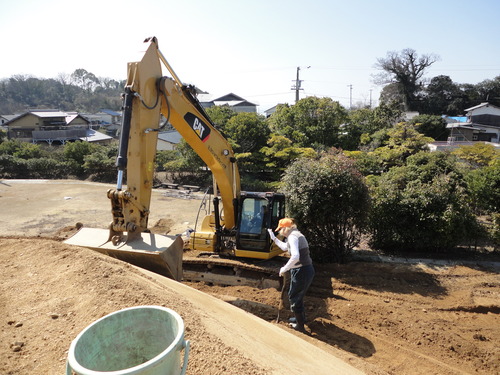
And here’s the finished product. The work uses no contemporary materials, only earth and grass, yet these primitive materials spark the imagination, generating “stratums” of thoughts. At least that’s the idea, and I would have to say that Tanya succeeded! A very interactive work that is great fun to climb.
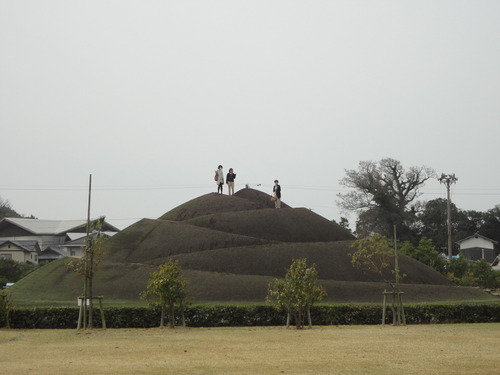
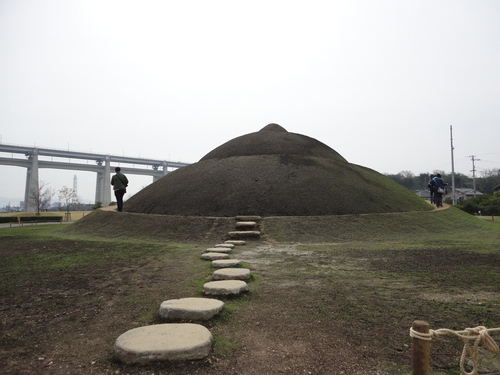

Our next stop was Eat & Art Taro. It was only 10:30, not time for lunch, but Triennale staff warned us that the Island Soup sells out early.
As we lined up for soup, the artist himself was there to describe the project. He spent many weeks combing the area to find indigenous ingredients that have been used for a 1000 years.

The soup (JPY500) is made only from these and flavored with salt and sesame oil. It’s a very light soup with 2 chewy chicken dumplings and what I would swear is a barnacle! But it was very tasty and quite an experience.

The box lunch (JPY600), made by the island women, was really good and the outdoor dining along the beach was a treat. I’m not sure what the plan is for rainy days but they don't have to worry about summer heat as the site is only open in the Spring Season (until April 21). In other words, go now!
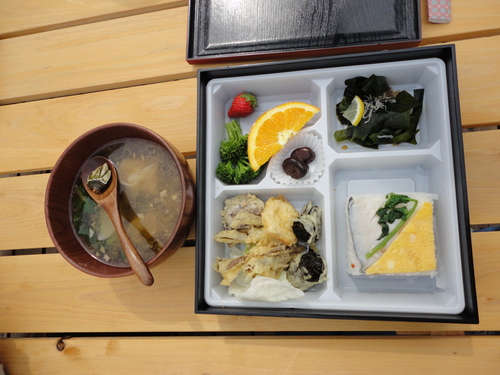

Stroll past the restaurant and you’ll come to Igarashi’s work, “Knitting the Sky”.
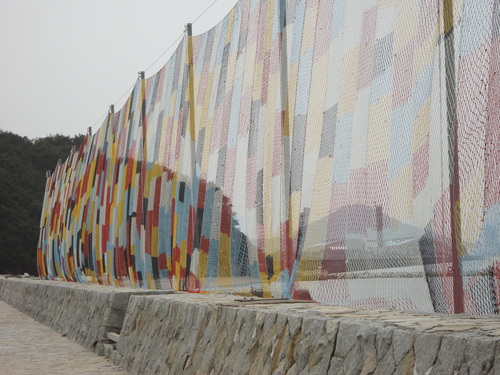
Local fishermen from all 5 islands in the Shamijima group taught local residents and volunteers how to knit fishing nets. They produce patches in 5 colors, representing the 5 islands as well as 5 elements in nature, which Yasuaki Igarashi stitched together to create this truly collaborative work.

It is meant not just to be seen, but also to seen through. It produces a really lovely and illusory effect.
We next took a stroll over the hill to the former elementary school which features installations by various artists affiliated with Kobe Design University. I must admit I was very pleasantly surprised by the caliber of the works here. The overall theme is “the three whites” which refers to 3 regional products known as Sanuki sanpaku (salt, sugar, and cotton), and each work deals with something white. Visitors entering the corridor are greeted by the sight of white Styrofoam collected from the sea floating ethereally in the air.
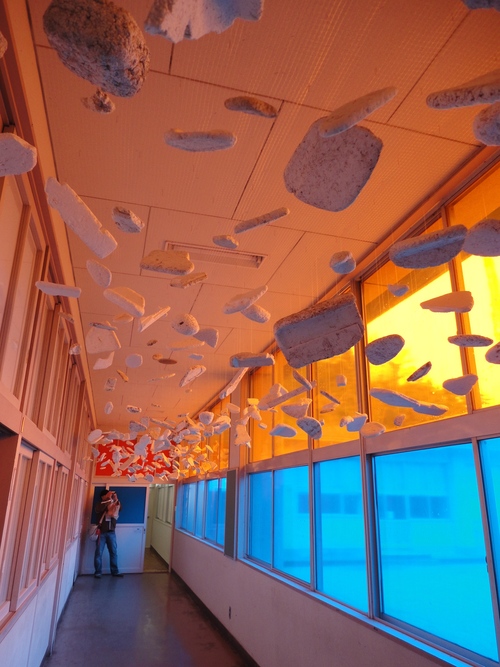
In a darkened room, a net of crystallized salt by Hana Sakuma sparkles like diamonds.

This is followed by a work painted with shells collected from the beach and painstakingly crushed by hammer (“Kaisou-shamijima” by Yukie Ohata). The textures were quite striking but much better seen in person so instead here is photo of the artist's message to visitors showing how the work was made. It's also painted not with chalk but with crushed shell paint.

The final work, “Shiro” by Kentaro Hayashi, is a totally white classroom complete with a white “blackboard” on which is projected the passage of time.

What I didn’t realize until we were on our way out is that the café at the entrance is also an installation. The table is shaped like Shamijima and the wall mural is a collaborative effort of the artist with local children. Lots of fun to look at, and you can enjoy sweets and coffee while you’re there.
And Shamijima is not just art. If you go, take a walk past this bench (another artwork) and around the shore.

“Love Nine-legged race, LOVE” by Syuzo Fujimoto
You’ll find a lovely little hiking trail through the woods that offers great views of the sea and islands.
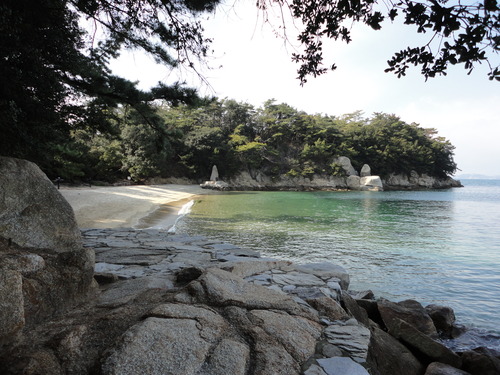

Sakaide is just a 15-min. train ride from JR Takamatsu station and the buses to Shamijima run at least every hour during the Triennale. For more about the Triennale, see http://setouchi-artfest.jp/en/ .
Takamatsu Access:
Takamatsu can be reached by direct flights from Tokyo’s Haneda Airport (about 1 hour), by limousine bus from Kansai International Airport (about 3 hours), and by direct flights from China, Korea and Taiwan. It can also be reached by taking the bullet train to Okayama (4 hours from Tokyo) and changing to the Marine Liner bound for Takamatsu (runs every 1/2 hour; takes 1 hour).
Hotels: http://www.japanican.com/index.aspx (when selecting the area of stay, scroll down to “Other Popular Options” and select “Takamatsu/Tokushima/Awashima”.)
Also check: http://www.kagawa-yadonet.or.jp/en/

The first art site that greets the visitor is Tanya Preminger’s “100 Stratums”. When I went in early March, it was still in process with Tanya fearlessly directing a great big digger to create a hill, and digging away with her shovel to shape the earth as she wished.

And here’s the finished product. The work uses no contemporary materials, only earth and grass, yet these primitive materials spark the imagination, generating “stratums” of thoughts. At least that’s the idea, and I would have to say that Tanya succeeded! A very interactive work that is great fun to climb.



Our next stop was Eat & Art Taro. It was only 10:30, not time for lunch, but Triennale staff warned us that the Island Soup sells out early.
As we lined up for soup, the artist himself was there to describe the project. He spent many weeks combing the area to find indigenous ingredients that have been used for a 1000 years.

The soup (JPY500) is made only from these and flavored with salt and sesame oil. It’s a very light soup with 2 chewy chicken dumplings and what I would swear is a barnacle! But it was very tasty and quite an experience.

The box lunch (JPY600), made by the island women, was really good and the outdoor dining along the beach was a treat. I’m not sure what the plan is for rainy days but they don't have to worry about summer heat as the site is only open in the Spring Season (until April 21). In other words, go now!


Stroll past the restaurant and you’ll come to Igarashi’s work, “Knitting the Sky”.

Local fishermen from all 5 islands in the Shamijima group taught local residents and volunteers how to knit fishing nets. They produce patches in 5 colors, representing the 5 islands as well as 5 elements in nature, which Yasuaki Igarashi stitched together to create this truly collaborative work.

It is meant not just to be seen, but also to seen through. It produces a really lovely and illusory effect.
We next took a stroll over the hill to the former elementary school which features installations by various artists affiliated with Kobe Design University. I must admit I was very pleasantly surprised by the caliber of the works here. The overall theme is “the three whites” which refers to 3 regional products known as Sanuki sanpaku (salt, sugar, and cotton), and each work deals with something white. Visitors entering the corridor are greeted by the sight of white Styrofoam collected from the sea floating ethereally in the air.

In a darkened room, a net of crystallized salt by Hana Sakuma sparkles like diamonds.
This is followed by a work painted with shells collected from the beach and painstakingly crushed by hammer (“Kaisou-shamijima” by Yukie Ohata). The textures were quite striking but much better seen in person so instead here is photo of the artist's message to visitors showing how the work was made. It's also painted not with chalk but with crushed shell paint.

The final work, “Shiro” by Kentaro Hayashi, is a totally white classroom complete with a white “blackboard” on which is projected the passage of time.

What I didn’t realize until we were on our way out is that the café at the entrance is also an installation. The table is shaped like Shamijima and the wall mural is a collaborative effort of the artist with local children. Lots of fun to look at, and you can enjoy sweets and coffee while you’re there.
And Shamijima is not just art. If you go, take a walk past this bench (another artwork) and around the shore.

“Love Nine-legged race, LOVE” by Syuzo Fujimoto
You’ll find a lovely little hiking trail through the woods that offers great views of the sea and islands.


Sakaide is just a 15-min. train ride from JR Takamatsu station and the buses to Shamijima run at least every hour during the Triennale. For more about the Triennale, see http://setouchi-artfest.jp/en/ .
Takamatsu Access:
Takamatsu can be reached by direct flights from Tokyo’s Haneda Airport (about 1 hour), by limousine bus from Kansai International Airport (about 3 hours), and by direct flights from China, Korea and Taiwan. It can also be reached by taking the bullet train to Okayama (4 hours from Tokyo) and changing to the Marine Liner bound for Takamatsu (runs every 1/2 hour; takes 1 hour).
Hotels: http://www.japanican.com/index.aspx (when selecting the area of stay, scroll down to “Other Popular Options” and select “Takamatsu/Tokushima/Awashima”.)
Also check: http://www.kagawa-yadonet.or.jp/en/
Posted by cathy at
20:41
│Comments(1)
2013年03月12日
Triennale 2013: Catching Up with Ogijima
One of the Triennale’s aims is to revitalize dying communities by using art to attract people to the islands. I recently checked with artist Yoshifumi Oshima of Onba Factory fame (see http://cathy.ashita-sanuki.jp/e266797.html ) about the Triennale’s effect on the island of Ogijima. Oshima and his wife participated in 2010 and have since become an integral part of the island’s community.

The Oshimas
Last time, Oshima said, the islanders had no idea what would happen and they waited for art festival organizers to take the lead. When their tiny island was deluged by hundreds of visitors, they very nearly panicked. This time, however, they are ready and eager to do something. Some have stepped forward to provide accommodation so that people can enjoy the best time on the island – the peaceful evenings and mornings. Pictured below is Minshuku Sakura, one of several lodgings that opened recently (http://takoyado.jimdo.com/ JPY3,000/night for lodging or JPY6,000-8,000 if you include dinner & breakfast).
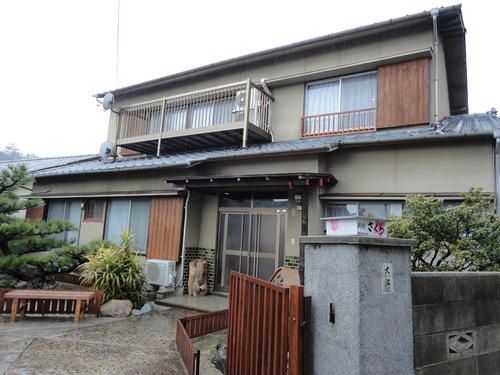
Another new addition is the Ogi Concierge project. The islanders have an immense love and pride for their island and are always kind and helpful to strangers. This makes them natural guides. Koebitai volunteers trained the islanders in the essentials of guiding to protect them from burnout, and badges designed by the village chief’s daughter will be worn to designate which islanders have the time an inclination to guide on any particular day.

Of course, the women’s association has been busy developing a menu of local dishes such as octopus tempura, seafood curry and stewed peanuts.

Stewed island-grown peanuts.
These will be served at the port in the building on the far left below.
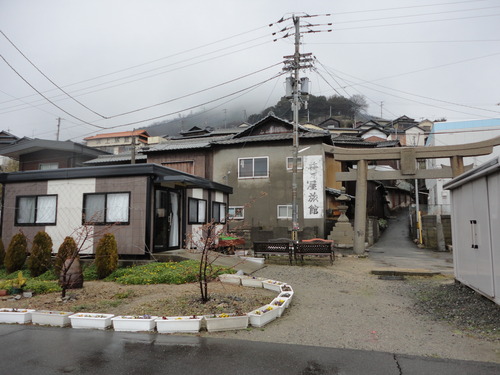
But none of these ideas sound like art, right? There is, of course, plenty of cool art to see on the island. However, as Oshima explained, “The real beauty of Ogijima is not the art but the people. The point is to find a way to attract repeaters and lay a foundation for younger generations to make a viable living on the island.”
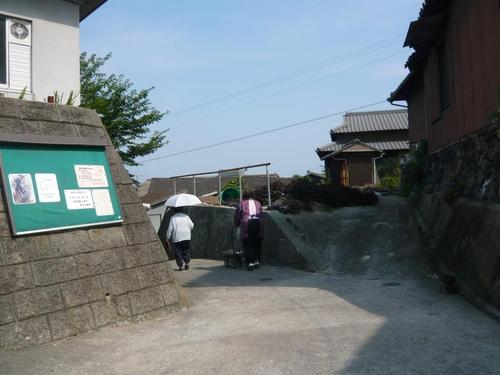
The island chief is encouraging villagers to maintain abandoned homes without which the village would lose its distinctive charm. Others are exploring experiential or eco-tourism, including fishing, farming and other aspects of the traditional island lifestyle. If these initiatives succeed in revitalizing the community, the Triennale will have a truly lasting impact. If not, advancing age will leave far fewer islanders for future Triennales.

For more on the Setouchi Triennale 2013, see http://setouchi-artfest.jp/en/ For ticket info, see http://setouchi-artfest.jp/en/tickets
Takamatsu Access:
Takamatsu can be reached by direct flights from Tokyo’s Haneda Airport (about 1 hour), by limousine bus from Kansai International Airport (about 3 hours), and by direct flights from China and Korea. It can also be reached by taking the bullet train to Okayama (4 hours from Tokyo) and changing to the Marine Liner bound for Takamatsu (runs every 1/2 hour; takes 1 hour).
Hotels: http://www.japanican.com/index.aspx (when selecting the area of stay, scroll down to “Other Popular Options” and select “Takamatsu/Tokushima/Awashima”.)
Also check: http://www.kagawa-yadonet.or.jp/en/

The Oshimas
Last time, Oshima said, the islanders had no idea what would happen and they waited for art festival organizers to take the lead. When their tiny island was deluged by hundreds of visitors, they very nearly panicked. This time, however, they are ready and eager to do something. Some have stepped forward to provide accommodation so that people can enjoy the best time on the island – the peaceful evenings and mornings. Pictured below is Minshuku Sakura, one of several lodgings that opened recently (http://takoyado.jimdo.com/ JPY3,000/night for lodging or JPY6,000-8,000 if you include dinner & breakfast).

Another new addition is the Ogi Concierge project. The islanders have an immense love and pride for their island and are always kind and helpful to strangers. This makes them natural guides. Koebitai volunteers trained the islanders in the essentials of guiding to protect them from burnout, and badges designed by the village chief’s daughter will be worn to designate which islanders have the time an inclination to guide on any particular day.

Of course, the women’s association has been busy developing a menu of local dishes such as octopus tempura, seafood curry and stewed peanuts.

Stewed island-grown peanuts.
These will be served at the port in the building on the far left below.

But none of these ideas sound like art, right? There is, of course, plenty of cool art to see on the island. However, as Oshima explained, “The real beauty of Ogijima is not the art but the people. The point is to find a way to attract repeaters and lay a foundation for younger generations to make a viable living on the island.”

The island chief is encouraging villagers to maintain abandoned homes without which the village would lose its distinctive charm. Others are exploring experiential or eco-tourism, including fishing, farming and other aspects of the traditional island lifestyle. If these initiatives succeed in revitalizing the community, the Triennale will have a truly lasting impact. If not, advancing age will leave far fewer islanders for future Triennales.

For more on the Setouchi Triennale 2013, see http://setouchi-artfest.jp/en/ For ticket info, see http://setouchi-artfest.jp/en/tickets
Takamatsu Access:
Takamatsu can be reached by direct flights from Tokyo’s Haneda Airport (about 1 hour), by limousine bus from Kansai International Airport (about 3 hours), and by direct flights from China and Korea. It can also be reached by taking the bullet train to Okayama (4 hours from Tokyo) and changing to the Marine Liner bound for Takamatsu (runs every 1/2 hour; takes 1 hour).
Hotels: http://www.japanican.com/index.aspx (when selecting the area of stay, scroll down to “Other Popular Options” and select “Takamatsu/Tokushima/Awashima”.)
Also check: http://www.kagawa-yadonet.or.jp/en/
Posted by cathy at
21:21
│Comments(1)
2013年03月01日
“Water Mirror”
There is so much to see at this year’s Setouchi Triennale that I can’t possibly cover it all. Instead, I’ll offer glimpses to entice those of you who can come to do so, and to encourage those who can’t to come next time (2016). Or you can come in between, because much of what is happening will continue between each festival. One thing I can tell you is that it’s going to be Awesome!
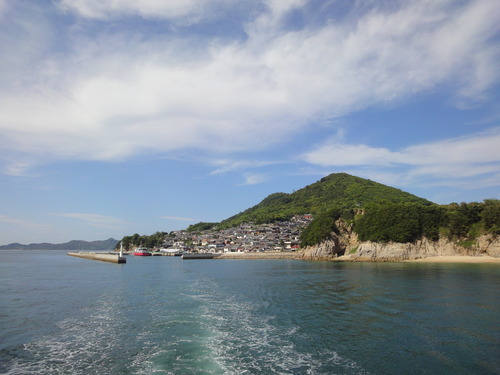
Today’s glimpse is from the little island of Ogijima, which will host 16 different art projects, of which 10 are new. One of these is “Water Mirror”, by artist Sayaka Ishizuka. Please note that all photos are of a work in progress. The finished product will be unveiled on March 20, 2013.

Artist explaining the concept
Sayaka first came to Ogijima in 2010 to help friend and fellow artist Rikuji Makabe produce the lovely clapboard collages scattered around the village.

Wallalley collage
She decided to come back for 2013, this time as a participating artist. (See her blog for photos of her life on Ogijima: http://utushimizu.blogspot.jp/ )
Her concept is to use treasured artifacts from island life to create "islands" suspended in space - a reflection of the Seto Inland Sea.
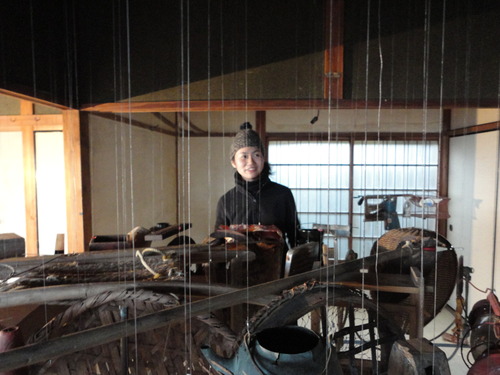
Sayaka Ishizuka with work in progress
After exploring the village, she chose the house of a diver with, very appropriately, a wonderful view overlooking the sea. She also went door-to-door, befriending the villagers and asking them to share fishing, farming and household implements.
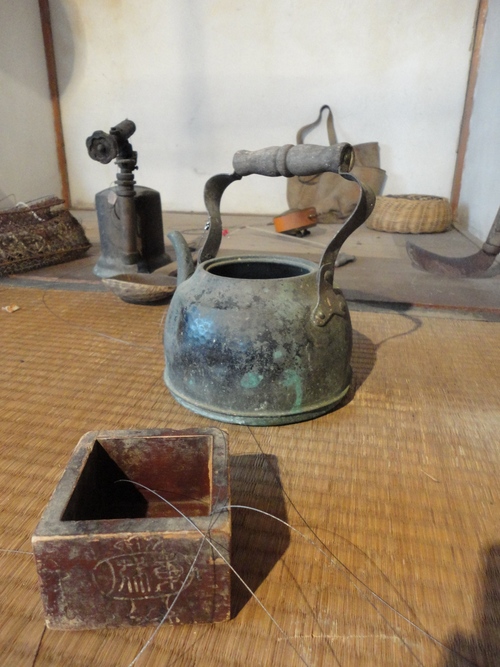
Although the work is still in progress, it was taking shape rapidly even while I was there with the help of a team of diligent volunteers.
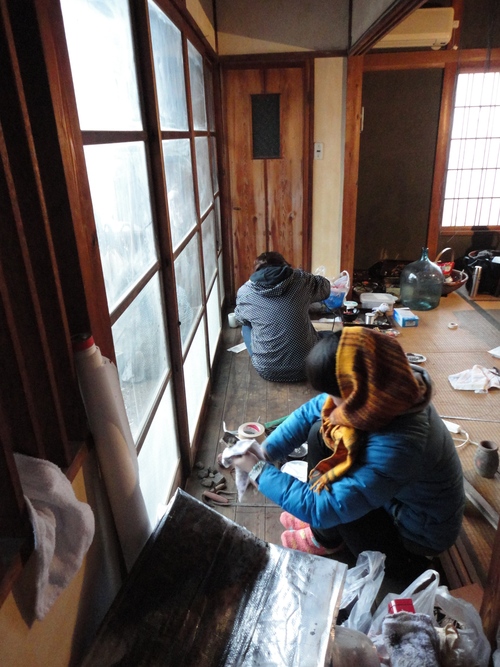

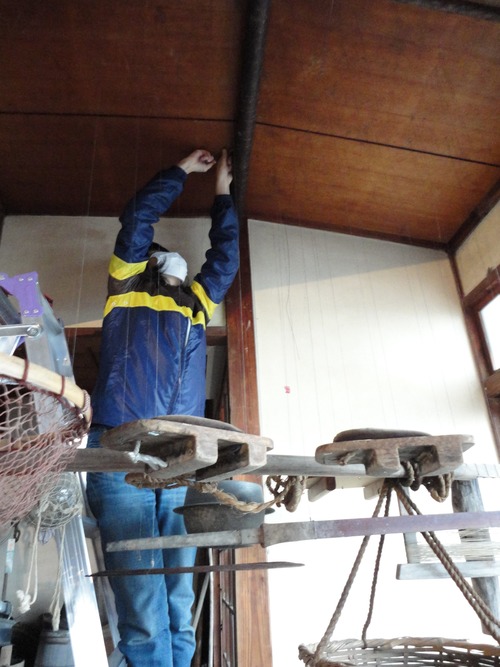
With all the weird and wonderful paraphernalia comprising each "island", it was already fascinating to look at. I'm looking forward to seeing the final result.
Ogijima Access: The island is 40 minutes by ferry from Takamatsu Port (JPY 1,000 round-trip; ferries run every 2 hours between 7AM & 5PM to the island, and every 2 hours between 7:40 AM to 5:40 PM from the island to Takamatsu.)
Takamatsu Access:
Takamatsu can be reached by direct flights from Tokyo’s Haneda Airport (about 1 hour), by limousine bus from Kansai International Airport (about 3 hours), and by direct flights from China and Korea. It can also be reached by taking the bullet train to Okayama (4 hours from Tokyo) and changing to the Marine Liner bound for Takamatsu (runs every 1/2 hour; takes 1 hour).
Hotels: http://www.japanican.com/index.aspx (when selecting the area of stay, scroll down to “Other Popular Options” and select “Takamatsu/Tokushima/Awashima”.)
Also check: http://www.kagawa-yadonet.or.jp/en/
Today’s glimpse is from the little island of Ogijima, which will host 16 different art projects, of which 10 are new. One of these is “Water Mirror”, by artist Sayaka Ishizuka. Please note that all photos are of a work in progress. The finished product will be unveiled on March 20, 2013.

Artist explaining the concept
Sayaka first came to Ogijima in 2010 to help friend and fellow artist Rikuji Makabe produce the lovely clapboard collages scattered around the village.
Wallalley collage
She decided to come back for 2013, this time as a participating artist. (See her blog for photos of her life on Ogijima: http://utushimizu.blogspot.jp/ )
Her concept is to use treasured artifacts from island life to create "islands" suspended in space - a reflection of the Seto Inland Sea.

Sayaka Ishizuka with work in progress
After exploring the village, she chose the house of a diver with, very appropriately, a wonderful view overlooking the sea. She also went door-to-door, befriending the villagers and asking them to share fishing, farming and household implements.

Although the work is still in progress, it was taking shape rapidly even while I was there with the help of a team of diligent volunteers.



With all the weird and wonderful paraphernalia comprising each "island", it was already fascinating to look at. I'm looking forward to seeing the final result.
Ogijima Access: The island is 40 minutes by ferry from Takamatsu Port (JPY 1,000 round-trip; ferries run every 2 hours between 7AM & 5PM to the island, and every 2 hours between 7:40 AM to 5:40 PM from the island to Takamatsu.)
Takamatsu Access:
Takamatsu can be reached by direct flights from Tokyo’s Haneda Airport (about 1 hour), by limousine bus from Kansai International Airport (about 3 hours), and by direct flights from China and Korea. It can also be reached by taking the bullet train to Okayama (4 hours from Tokyo) and changing to the Marine Liner bound for Takamatsu (runs every 1/2 hour; takes 1 hour).
Hotels: http://www.japanican.com/index.aspx (when selecting the area of stay, scroll down to “Other Popular Options” and select “Takamatsu/Tokushima/Awashima”.)
Also check: http://www.kagawa-yadonet.or.jp/en/
Posted by cathy at
01:07
│Comments(3)



